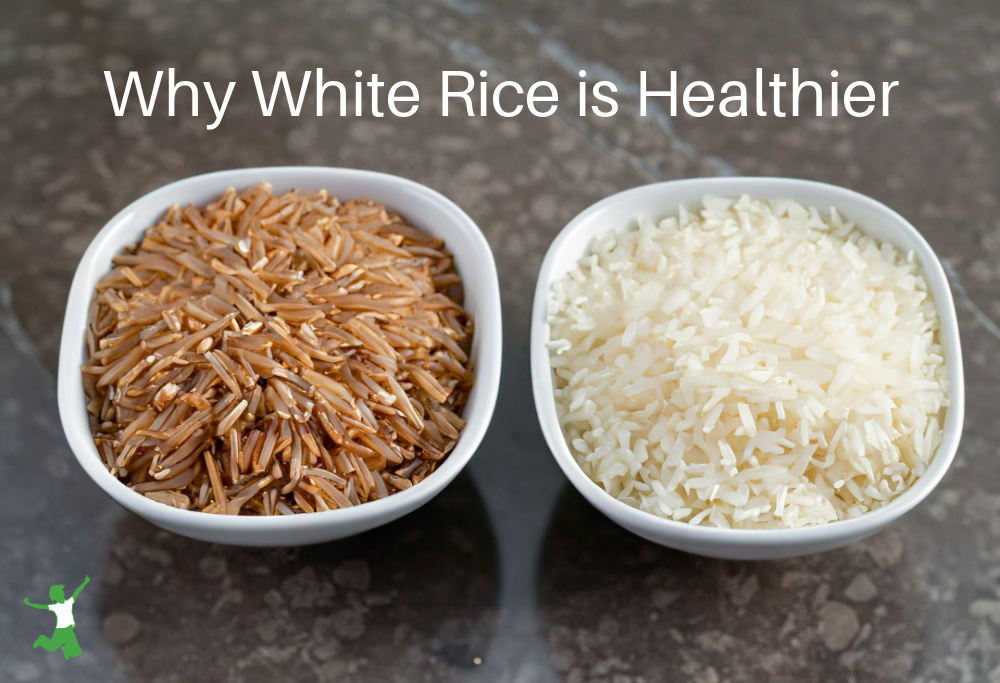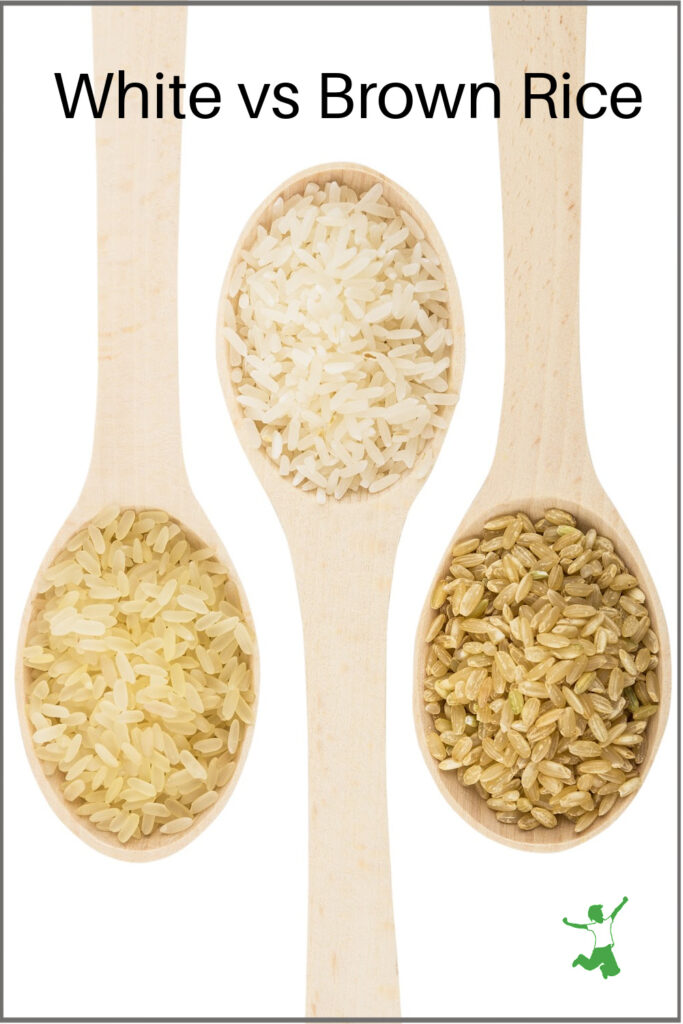The reasons white rice is healthier than brown rice as determined by research as well as which type traditional societies preferred consuming.

My article and video on healthy Chinese food drew some comments from readers who questioned my choice of rice.
Why was I using white rice vs brown? Isn’t brown rice the healthier choice, after all?
Ok, I’ll spill the beans, rice. Here are my reasons …
The truth is, neither my husband nor myself have ever enjoyed brown rice (although we love the nutty flavor and digestibility of wild rice).
Every time we eat brown, it just seems to not sit very well in our stomachs.
Even when it is sprouted or soaked before cooking, it, well, uh, sits like a brick for lack of a better word.
Why Some People Should Eat White Rice
White rice just seems to digest a whole lot better for us. That to me was reason enough to choose it over the brown rice.
We were also advised by an Ayurvedic MD back in the 1990s to stick with white basmati rice. This recommendation clinched the decision.
You are what you digest, after all – not necessarily what you eat!
End of story? Well, not quite.
Rice Fiber in Brown Harms a Compromised Gut
A few years back at the annual Wise Traditions Conference, I became familiar with a compelling book called Fiber Menace.
The author writes extensively about the dangers of a high-fiber diet as it pertains to a menu loaded with whole grains as pushed by the misguided Food Pyramid.
In other words, folks who eat a bowl of All Bran every morning to keep the bathroom visits regular are unknowingly ripping their insides to shreds.
The basic premise of Fiber Menace is that grain fiber plays a leading role in many gut-related ailments including colon cancer.
When I first learned of this information, my preference for white rice over brown rice started to make more sense.
Perhaps the brown rice didn’t digest that well because of all that fiber?
Chalk one up for the white rice.
White Rice Far Lower in Phytic Acid
A second piece of information came from author Ramiel Nagel.
In his book, Cure Tooth Decay, he writes about the devastating effects of phytic acid in the diet. Phytic acid is a very powerful antinutrient and blocker of mineral absorption in the gut.
Mr. Nagel identifies brown rice as very high in phytic acid.
What’s more, soaking brown rice does not reduce phytic acid by much at all!
Polished Rice is the Ancestral Form
Ramiel also maintains that the traditional method for preparing brown rice is never to eat it whole (with only the husk removed).
Rather, ancestral societies pounded brown rice in a mortar and pestle to polish it by removing the outer bran layer. This is the primary source of the phytic acid.
Nagel goes on to point out that experiments have shown that the milled and polished rice that results from this pounding process, has the highest mineral absorption.
In short, mineral absorption from whole brown rice is much less than white polished rice. This is because the phytic acid in the bran which is not reduced much by soaking, greatly interferes with the absorption process.
What About Arsenic?
A big issue with arsenic contamination in rice has emerged in recent years. Some folks have responded by no longer eating rice at all.
This is an overreaction, in my view.
Clean rice is definitely available if you know what to look for.
This article on how to avoid arsenic in rice details what to do. While soaking brown rice barely moves the needle on phytic acid, soaking white rice before cooking removes nearly all the arsenic!
Another option is to parboil white rice before using fresh water for a full cook if you don’t have time to soak.
Is White Rice Better Than Brown?
So it seems that brown rice is not necessarily a healthier choice than milled white rice.
Black or red rice would fall into the same category.
Obviously, whether you choose one or the other is a personal preference, but I hope this information helps you sort through the decision with a bit more clarity.
As for me and my family, we will be sticking with white basmati and jasmine rice (white basmati rice is more nutritious than plain white rice).
I currently buy this brand of rice in 25-pound bags as the most economical and high-quality choice.
Observation clued me in many years ago that brown rice was not something that was sitting well in my stomach or my husband’s.
As the years go by, more research is coming forth to indicate that this decision was the right way to go after all.
Do you eat white rice or brown rice in your home? Why or why not?

References
(1) Fiber Menace
(2) Living with Phytic Acid
More Information
Macrobiotic Diet and Extreme Vitamin D Deficiency
Tiny Teff Grains Deliver Big on Nutrition
How to Make Perfect Yellow Rice (Arroz Amarillo)
Millet: Healthy or Not?
Do Whole Grains Cause Cavities?







you mean I might be eating something that is good for me that be a change yippppeeeee
Thank you Sarah for another great article. A few years ago I read Whole Don’t Mean Wholesome by Clive Lawler about 2007 where I first came across this. He made sense but I wasn’t quite sure because Nourishing Traditions did advocate brown rice. Now more & more information is coming through that confirms this so we have now been eating only organic white basmati for a couple of years & no one complains about bloating after eating it. Thanks for the update on jasmine rice.
Interesting! I, though, just adore my nutty, sweet, organic, short grain brown rice!
no rice no grains no beans!!!!!
I eat brown basmati. Honestly I just prefer the taste. Like floral popcorn when toasted for a few minutes before simmering 🙂 Nourishing traditions mentions something about some people having the microorganisms in their gut to break down the phytic acid in grains- I’m thinking that’s me because I LOVE brown basmati. 🙂 But to be safe, I do sprout it, and this way I get increased vitamins and much higher protein than white rice.
I’ from India and only eat white basmati rice. for some reason the brown rice doesn’t taste good with curries!
Hi Sarah, Do you have any comments regarding the Macrobiotic diet and the amount of grains, they eat? A Macro diet consists of about 40/50% grains, a lot of brown rice. We ate vegan/macro for a while but have done a complete 180 and eat a more GAPS/WAPF. The thing is is that I know quiet a few people who eat macrobiotically and enjoy near perfect heath, and I must say that a bowl of brown rice and veggies has a calming effect on my tummy.
I eat organic brown basmati rice. White rice of any kind spikes my blood sugar significantly and with so many diabetics in my family I try to avoid foods with a high glycemic index. The brown basmati rice hasn’t given me any digestive issues but I eat a lot of fermented foods like kefir and kimchi and don’t really have any digestive issues anymore. (I used to be lactose intolerant but since using probiotics I have no more issues). As with anything, I think you should eat whatever works best for you and your family. Everyone is different. Some people don’t have blood sugar issues.
This article makes perfect sense to me. I, too, stayed away from high fiber grains because I could feel it ripping my gut apart, and always felt guilty, because, you know, we’re all supposed to live off bran flakes and bran muffins, or or it seemed for a few years there. Truth is, I’m not big on rice at all. I may want it as a side once or twice a year, and when I do, I have always mixed them. Probably 1/3 brown and the rest white rice, with a handful of “wild rice” thrown in. Yes, I know “wild rice” is not rice but a reed, but it does go well with other rice. I have a tendency to boil my rice first, then fry it with whatever I’m cooking as well for flavor. Poor stuff is cooked to death, I’d be surprised if there are any nutrients left! So I don’t count on rice for nutritian.
we eat both 🙂